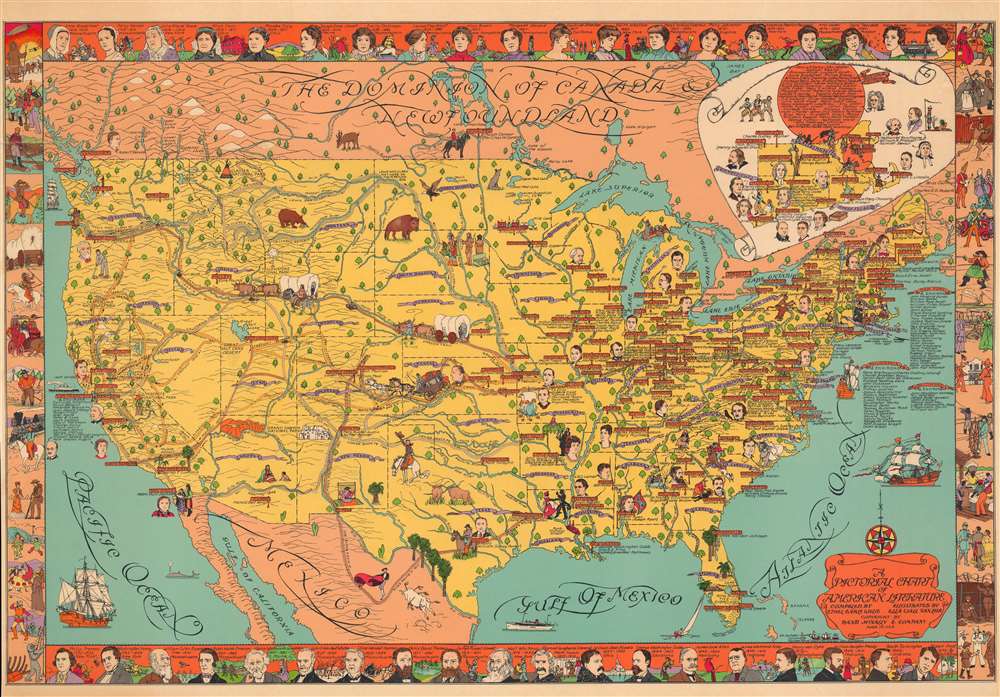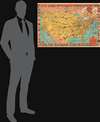Digital Image: 1932 Wylie and Van Leer Pictorial Map of the United States and American Literature
AmericanLiterature-wylievanleer-1932_d
Title
1932 (undated) 26.25 x 39.25 in (66.675 x 99.695 cm) 1 : 5700000
Description
FOR THE ORIGINAL ANTIQUE MAP, WITH HISTORICAL ANALYSIS, CLICK HERE.
Digital Map Information
Geographicus maintains an archive of high-resolution rare map scans. We scan our maps at 300 DPI or higher, with newer images being 600 DPI, (either TIFF or JPEG, depending on when the scan was done) which is most cases in suitable for enlargement and printing.
Delivery
Once you purchase our digital scan service, you will receive a download link via email - usually within seconds. Digital orders are delivered as ZIP files, an industry standard file compression protocol that any computer should be able to unpack. Some of our files are very large, and can take some time to download. Most files are saved into your computer's 'Downloads' folder. All delivery is electronic. No physical product is shipped.
Credit and Scope of Use
You can use your digial image any way you want! Our digital images are unrestricted by copyright and can be used, modified, and published freely. The textual description that accompanies the original antique map is not included in the sale of digital images and remains protected by copyright. That said, we put significant care and effort into scanning and editing these maps, and we’d appreciate a credit when possible. Should you wish to credit us, please use the following credit line:
Courtesy of Geographicus Rare Antique Maps (https://www.geographicus.com).
How Large Can I Print?
In general, at 300 DPI, you should at least be able to double the size of the actual image, more so with our 600 DPI images. So, if the original was 10 x 12 inches, you can print at 20 x 24 inches, without quality loss. If your display requirements can accommodate some loss in image quality, you can make it even larger. That being said, no quality of scan will allow you to blow up at 10 x 12 inch map to wall size without significant quality loss. For more information, it is best consult a printer or reprographics specialist.
Refunds
If the high resolution image you ordered is unavailable, we will fully refund your purchase. Otherwise, digital images scans are a service, not a tangible product, and cannot be returned or refunded once the download link is used.
Cartographer S
Ethel Earle Wylie (1881 - 1962) was a Canadian American artist and teacher. Born in Canada, Wylie immigrated to the United States in 1889. Very little is known about her life and career, but we do know that she spent some time as a teacher in Oakland, California. It appears that she was also an extensive traveler, spending as much as six months in Europe at once. More by this mapmaker...
Ella Lillian Wall Van Leer (November 11, 1892 - August 8, 1986) was an American architect, artist, and women's rights activist. Born in Berkeley, California, Wall graduated from Berkeley High School in 1910 and then attended the University of California Berkeley. She received her M.A. in Art and Architecture from U.C. Berkeley in 1915. Even after earning a master's degree, she was not able to become a professional architect and was relegated to teaching both subjects at the high school level later in life. One of her first jobs after graduation was as an artist for Rand McNally. She enlisted in the Army Nursing Corps at Letterman Army Hospital on the Presidio in San Francisco in July 1918. She was mobilized for overseas servicer four months later. She served overseas until March 1920, then had a position at the U.S.A. General Hospital. Eventually she made her way back to California and found a teaching position. She became the first woman to hold an office in the American Legion in California in 1923 when she became second vice commander of Berkeley Post No. 7. Wall married Blake Ragsdale Van Leer in 1924 and continued pursuing her career as an artist during her marriage. She worked as an illustrator for Rand McNally (perhaps she had a position waiting for her after her Army service?) and Wall worked in the office of the Quartermaster General during World War II as a principal draftsman and technologist of the research and development branch in Washington, D.C. Wall's husband became president of the Georgia Institute of Technology in 1944 and she became the 'backbone of women' and their 'unofficial dean' not long after arrival. She tirelessly campaigned for women's rights and even successfully petitioned to overturn a statute barring women from enrolling at Georgia Tech. After the first women enrolled at the school, Wall helped establish the first scholarship for female students, along with an official chapter of the Alpha Xi Delta sorority, the first sorority at an engineering school. Her husband died in 1956 and Wall bought a house near Georgia Tech and turned it into 'an unofficial women's dormitory'. She retired in 1976. Wall died in Arlington, Virginia, and is buried at the Marietta National Cemetery in Cobb County, Georgia. She and her husband had two children. Learn More...




